A lot of books have been written about the 80 Year War by Englishmen like Walter Morgan, Coldecott-Blair, Motley and Parker. Despite this (and the fact there was British involvement in the conflict) it looks to me as if little attention is paid to this period in wargaming This is a pity, since the first half of the war (in particular) is full of small scale encounters, skirmishes, sieges (both big & small), larger battles, naval encounters and some very interesting campaigns.
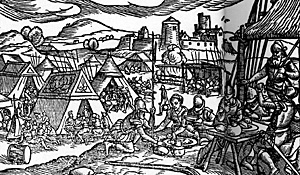 Perhaps this is partly due to the trend in the hobby to larger scale actions and also because
there aren't any specific rules that cover the way war was waged in The Netherlands. I can also
imagine, because this is a period of transition in dress and equipment, it's difficult to find the right figures. However there are some nice ranges available which cover this period rather well. In case there is a lack of specific military information, I'll try to do something on it by dealing with some military actions which are interesting for wargaming. l intend to write some articles covering battles or encounters during the first half of the war from 1568 up to 1609.
Perhaps this is partly due to the trend in the hobby to larger scale actions and also because
there aren't any specific rules that cover the way war was waged in The Netherlands. I can also
imagine, because this is a period of transition in dress and equipment, it's difficult to find the right figures. However there are some nice ranges available which cover this period rather well. In case there is a lack of specific military information, I'll try to do something on it by dealing with some military actions which are interesting for wargaming. l intend to write some articles covering battles or encounters during the first half of the war from 1568 up to 1609.
BACKGROUND
For those readers not familiar with the 80 Years War in The Netherlands, I'll give some brief background information. In 1555 Philip II of Spain succeeded his father as King of Spain and as such also as landlord of The Netherlands. The Netherlands were made up of 17 Provinces, comprising nowadays Netherlands, Belgium and Luxemburg. Philip intended to make a puppet kingdom of The Netherlands, along the lines of his homeland Spain. This meant that no other religion than the Catholic one would be permitted and that the role of the Dutch opposition.
The common people who saw the greedy Catholic Church as one of the causes of the worsening economic situation and who had an ear for the Calvinists, soon went over to violence. The result was the Iconoclastic Fury of 1566. In 1567 king Philip sent a punitive expedition to The Netherlands under command of the Duke Ol Alva. In 1568 William of Orange, the leading man of the higher nobility, which had formed a League against Philip, planned an invasion of The Netherlands. This was the beginning of the 80 Years War, a struggle for independence and freedom of religion in The Netherlands.
THE 1568 CAMPAIGN
In 1566 William and his brother Louis of Nassau had tried to hire German troops. Despite several reverses William was able to plan a three-pronged invasion of The Netherlands in the Spring of 1568; through Artois in the South, Limburg in the South East and Friesland in the North. This was aimed at scattering Alva's troops, which were now concentrated in the Southern Provinces. William himself waited with an 8,000 strong mercenary force near the German town Cleve to strike at Brussels, once the other attacks had succeeded.
However, the invasions from the South and South-East failed. William advised his brother Louis to abort the invasion from the North, because Alva was now free to concentrate his troops against him. Louis however thought that the population of the Northern Provinces were in the right mood and would welcome and support an invasion. For a more detailed background and a more comprehensive account of the 1568 campaign refer to my 80 YW series in Renaissance N&O or to the bibliography.
The Campaign Map
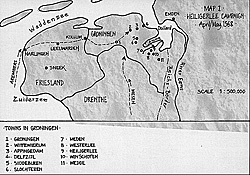
Larger version - very slow (105K)
Jumbo version - very slow (385K)
RECRUITING AND PRELIMINARY MOVES
MAP I shows the campaign area of Louis of Nassau's operation. Louis started with bad luck.
The Count of East Friesland refused to let his capital Emden be used as an embarkation
 place or as a mustering centre for Louis' rebel army. So the invasion by sea, which originally
was planned had to be abandoned and Louis decided to raise a land-force on Dutch soil. He
crossed the Reichs-border on April 23rd with 12 horsemen and 70 foot.
place or as a mustering centre for Louis' rebel army. So the invasion by sea, which originally
was planned had to be abandoned and Louis decided to raise a land-force on Dutch soil. He
crossed the Reichs-border on April 23rd with 12 horsemen and 70 foot.
Next day he surprised the garrison of the Wedde Castle and turned it into his central mustering place. Being surrounded by almost impregnable marshes and moors, he had gained an extremely well defensible base for his operations. Troops kept coming in and by April 27th his force mustered 700 men. On May 2nd he made Appingedam his headquarters, where his brother Count Adolf of Nassau join him with 200 German cavalry. From Germany some 800 survivors from the defeated invasion force from the South-East arrived, filled with hatred against the cruel Spaniards. On May 5th he occupied Slochteren, from where he tried to surprise the town of Groningen. His men were repulsed, but managed to take about 300 prisoners whose arquebuses were welcome. By now Louis controlled the greater part of the Province of Groningen. He detached 7 companies to guard the approach lines from the East and the South. The main body of 15 companies and the cavalry was concentrated around Appingedam, 4 companies covering their front at Wittewierum, from where Alva's troops were expected. From the coast the Sea-Beggars controlled the coastal areas and supplied his force with provisions through the harbour of Delfzijl.
Map II
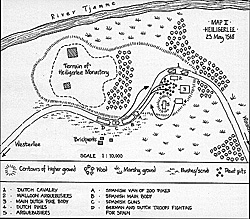
Larger version - very slow (141K)
Jumbo version - very slow (475K)
The Spanish troops were very close already. Alva had ordered the Stadhouder of the Provinces Friesland, Groningen and Overijssel, the Count Aremberg and the Stadhouder of the Province Gelre, the Count Megen, to eliminate the rebel forces in the North without mercy. They were to be assisted by Braccamonte, who left 's-Hertogenbosch with his Sardinian tercio to meet Aremberg and Megen in the North. The original plan was that the Spaniards would land on the Coast of Groningen, but hearing that the Waddenzee was controlled by the Sea-Beggars, plans had to be changed. On May 14th Braccamonte left Amsterdam and disembarked at Harlingen. There he joined Aremberg who, accompanied by a small body of cavalry, took over general command. In Friesland his troops were reinforced by 4 companies of his own regiment, which were garrisoned in Sneek and Lecuwarden. On May 20th Aremberg arrived at Groningen Here he was joined by a company of German infantry, which had departed from its garrision place in Gelre.
Although he wasn't allowed to enter the town, he was supplied with victuals, horses, pontoons and 6 guns. On May 21st there was a fight at Wittewierum, where Louis' men managed to escape under the cover of darkness. Louis realized that his army was no match for the trained and eager Spaniards. Besides many of his mercenaries got impatient, due to pay being in arrears. Therefore he decided to retreat before Megen could reinforce Aremberg. He hoped that Aremberg, who was blamed by the Spaniards for letting him escape, would try to follow and defeat him as soon as possible, without waiting for Megen. Megen had meanwhile left Arnhem on May 17th with about 1,800 men. He had orders to cut off Louis of Nassau's retreat route to the East or South and to assist Aremberg in case of a battle.
Louis retreated by way of Sidderburen, Slochteren, Meden and Westerlee to the heights that surrounded the monastery of Heiligerlee. Here he halted for a rest, but when news came of Aremberg's pursuit, Louis decided that the terrain was well suited for a defensive action. So his army took positions to await Aremberg and offer battle. Prior to the battle 2 German companies left his army, fearing that they would be slaughtered by the Spaniards. By now, having withdrawn his flank guards, Louis could field about 4,000 men, with further reinforcements expected from Germany.
HEILIGERLEE, THE BATTLE
As with many battles, this one is also surrounded by myths and uncertainties with regard to the battlefield, the position of Louis' troops and the numbers on both sides. I think I have come to an acceptable account by comparing several contemporary accounts with more modern analyses. MAP II shows the terrain of the forthcoming battle and the initial positions of both armies on May 23rd at 5.30 PM. The terrain was favourable for a defensive position. The monastery was built on the West side of a 1 km square of higher ground, of which the centre lay about 4.5 metres above water level.The surrounding area was rather below water-level. The ground between the road and the hills was covered with peat-pits, which at that time of the year were filled with water and overgrown with grass and bushes. This part of the terrain came as a surprise for those who advanced from the direction of Westerlee, because this road was surrounded by bushes till it entered the higher ground. A great part of Louis army was therefore out of sight of the approaching enemy. The cavalry (1) was posted on the road through the wood, with about 100 horse in a more advanced position where the road entered into the open. A body of Walloon arquebusiers (2) was hidden in a dry ditch; 3 companies totalling about 450 men. These arquebusiers were able to cover the retreat of the cavalry after an attack and also to give a flanking fire on the enemy when attacking the largest pike-body (3). This body was composed of 12 companies and included arquebusiers on its flanks, totalling about 1,800 men.
This body was the only clearly visible part of the army. Probably Louis had also ordered a few flags to be shown, in order to deceive the enemy about his strength. South of the main body another formation (4) of pikemen was placed just behind a small hill. This body was composed of 6 companies, totalling about 900 men. These were covered by a body of arquebusiers (5) which was partly hidden behind the crest of the same hill; 2 companies, totalling about 300 men.
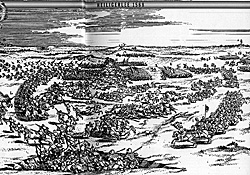
Larger version of the Battle of Heiligerlee 1568 - very slow (135K)
Aremberg knew the area and how treacherous the terrain could be and intended to keep Louis busy with some skirmishing until Megen arrived. Louis showed himself to be a keen general. He knew that the Spaniards were too proud to accept orders from the Dutch and also that Aremberg desired to show Braccamonte that he was not in league with the enemy. So Louis ordered his brother Adolf to cause some disorder within the Spanish ranks with 100 of his cavalry and try to tempt them to attack his position. So it happened. Braccamonte immediately ignored Arembergs advice and ordered the van of 200 pikemen (A) to pursue the retreating cavalry.
As soon as the Spanish pikemen entered the open terrain they were
shot at by the 400 arquebusiers who appeared on the crest of the hill. Mendoca says that Braccamonte ordered a skirmish screen of arquebusiers forward to counter the Dutch arquebusiers, but no other source mentions this. Aremberg ordered his guns (C) forward, the fire of which forced the Dutch arquebusiers to retire behind the crest of the hill. The Spanish van
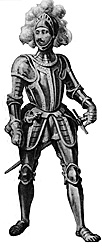 seeing this continued its advance. Immediately Aremberg directed the artillery fire at the
large pike-body, upon which the latter feigned a retreat. The Spanish van immediately reacted by leaving the road and advancing towards the Dutch infantry. The Spanish main body (B) took the place of the van on the road and received a flanking fire from the arquebusiers, which had
reappeared on the crest of the hill. Meanwhile Arembergs artillery had caused the first casualties on the large pike body. This caused the fanatic Spaniards to leave the road and take positions alongside the van to attack the large pike block. However soon most of the Spanish troops were entangled in the difficult terrain and came under fire from both Dutch arquebusier formations. The up to now hidden Walloon arquebusiers poured their fire into the left flank of the Spanish troops. To make things worse for the Spanish, the previously
concealed smaller pike-formation rounded the hill from the South over a hidden path. They attacked the Spanish troops, which had managed to form a line of attack, in their right flank.
seeing this continued its advance. Immediately Aremberg directed the artillery fire at the
large pike-body, upon which the latter feigned a retreat. The Spanish van immediately reacted by leaving the road and advancing towards the Dutch infantry. The Spanish main body (B) took the place of the van on the road and received a flanking fire from the arquebusiers, which had
reappeared on the crest of the hill. Meanwhile Arembergs artillery had caused the first casualties on the large pike body. This caused the fanatic Spaniards to leave the road and take positions alongside the van to attack the large pike block. However soon most of the Spanish troops were entangled in the difficult terrain and came under fire from both Dutch arquebusier formations. The up to now hidden Walloon arquebusiers poured their fire into the left flank of the Spanish troops. To make things worse for the Spanish, the previously
concealed smaller pike-formation rounded the hill from the South over a hidden path. They attacked the Spanish troops, which had managed to form a line of attack, in their right flank.
The Dutch cavalry under Adolf had meanwhile attacked Aremberg's artillery in it's flank. and afterwards. It,, their attention to the rear of the Spanish infantry. Although attacked from all sides the Spaniards at first refused to give way, but as sudden panic spread among their ranks, upon which most tried to escape. Aremberg wasn't able to rally his troops. Or their flight the up to now inactive German and Dutch troops (D) were swept before them. Those who sought refuge in the monastery were killed afterwards, while the rest retreated in the direction they had come from.
Losses were great. The Protestants are said to have revenged the massacre of the invasion troops the month before. Accounts of Spanish losses are contradictory, amounting to 1,700 killed and wounded. Mendoca mentions 450 dead, most of ther Spanish, including 3 captains and 7 standard-bearers and 300 Germans taken prisoner. The most important casualty on the Spanish side was the Count of Aremberg, who fell in the last stage of the battle when trying to rally his men. Moreover the artillery, 14 flags, the baggage train of 400 waggons and thw warchest with 3 month's pay for Arembergs army were captured. Dutch losses are estimated at only 40 killed and 200 wounded, amongst them however was William's brother Adolf. He was the first of 4 Nassau brothers who would give their lives for the Protestant cause and the freedom of The Netherlands.
THE ORANGIST TROOPS
The infantry was for the greater part composed of German mercenaries, but also included Walloon Protestants and about 270 Beggars (Geuzen) troops From the Northern Provinces Groningen and Friesland. Amongst the captains that commanded the companies were several Beggars, Germans and also some French Huguenots. For those interested I'll give the names of the 23 company commanders which served Louis at Heiligerlee. They are taken from the personal correspondence of Louis of Nassau:Henrick van Sieghen, Claes van Eppen, Johan van Holl, Curt van Botmer, Hans van Bloe, Henrick Butjenther, Henrick van Eime, Wilhelm van Dockum, Claes van Bremen. Otto Falcke. Ymmel op Leewaerden, Homme Hettinga (one of the prominent Frisian Beggars). Johann Bunghe, Johan van der Cate, Steven van Hartfelt, N. Van Culenbourg, Van der Turck, Peeter van Berchem, Frantz van Essen, Houtain, Stenzel van Namsloo, Rudolf van Minne and Jennin (a well-known Huguenot).
Sieghen and Eppen commanded according to Louis' correspondence 2 companies each, so that we reach a maximum of 25 companies. Louis mentions that Jennin's company was 150 strong and in several accounts of the events during April and May there are also some references to commissions given for raising 150 strong companies. Some years later there are indications that the company strength should have been 200 and that the regulations are based on that number. However, since there were many deserters amongst the Germans, and lacking other reliable information, the number of 150 seems a reasonable average to me, leading to a total of about 3,750 infantry. This fits rather well the numbers mentioned by sources like Mendoca, who refers to 3,600 infantry. About 50% might have been armed with arquebuses. Of the other half most will have been armed with pikes, however the Frisians may also have been armed with 2- handed swords or broadswords and other cut and thrust weapons. The companies were formed into larger battle-formations as indicated on map II, commanded as following. The Walloon arquebusiers were commanded by Gerrit van der Knijp, the larger body of pikeman by Henrick van Sieghen and the smaller body of pikeman and the aquebusiers in front by Louis personally.
The number of cavalry differs in the sources too. Some say that only the 200 German reiter of Adolf van Nassau were present, though several sources refer to 300 cavalry in total.
The other 100 might have been locally raised mounted Beggar troops and some Germans which Louis had brought with him. Adolf's cavalry in most sources is indicated as being reiters (or in some cases Carabiniers). They are best represented as German Reiters with 3/4 armour & armed with a pair of pistols and/or a carbine. It's up to you whether you wish to use 200 or 300 cavalry. Anyway they were organised into companies of 100 under the command of Adolf of Nassau.
- Of artillery at Louis's disposal I haven't found any evidence.
- The total of Louis's force thus may have been about 4,000. Accounts vary between 3-5,000.
- What is interesting is that Louis was expecting the following reinforcements:
- 300 cavalry under the German Count Jost zu Schauenburg (his nephew). He was actually appointed as Marechal de Camp.
- 800 Walloon arquebusiers under the Lord of Del Vaux.
- 200 Arquebusiers under the Count of Mansfeld.
- 2 companies of the Dutch Counts Van den Begh (his brother in law) and Culemborch (about 300 men).
- German arquebusiers which Sonnay was recruiting in Bremen.
Of these reinforcements Schauenburg is known to have arrived within a few days, the others a week or later.
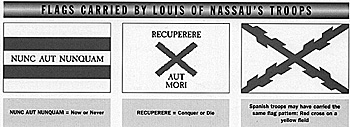
THE SPANISH TROOPS
The troops under Aremberg's command comprised the following:The Tercio of Sardinia, commanded by Don Gonzalo de Braccamonte. Initially this tercio counted 1,728 men. Mendoca refers to 400 arquebusiers having returned some time before to Italy. Mendoca also speaks of 1,000 survivors and 450 killed from the Spanish troops present at Heiligerlee. Being it's first real action in The Netherlands the number present at Heiligerlee might thus have been between 1,400 and 1,500. It's also possible of course that they had been reinforced by troops from other tercio's, although that's unlikely. The ratio of shot to pike was about 1:5. Since 400 arquebusier had left already, it's probable that new ones will have been added, since a tercio wouldn't go into action without a reasonable portion of shot. Their number can only be guessed. Perhaps they had been replaced by pikemen of their own tercio, temporarily transformed into arquebusiers or from other tercio's. Alva also introduced the musketeers to the tercio's in The Netherlands. The average under Alva was: 6% company staff, 8% musketeers, 20% arquebusiers and 66% pikes.
4 Companies of Aremberg's own regiment, being a so-called Low German regiment, that is with a Dutch colonelcy and primarily raised and recruited in the Netherlands. Contemporary accounts of similar regiment refer to 300-400 strong companies. The companies of Megen are said to have averaged 375, so let's take Aremberg's at 350. Up to 50% may have been armed with arquebus, the rest with pikes and some halberds. They were commanded by Jacob Huisinge.
1 Company of the German Schaumburg regiment, from the garrison of Groningen. Being of a German regiment, it's company strength may have varied between 200-400, so let's take 300. About 50% may have been fire-armed, while the other 50% were pikemen and to a lesser degree halberdiers and some 2-handed swordsmen. It was commanded by Hans Coenraet. Between 20 and 50 cavalry, the exact number being unknown. These were probably from Aremberg's own Bande d'Ordonnance, partly being heavy cavalry equipped like the French gendarmes.
6 Medium guns from Groningen, three 4 pdrs and 3 'halbschlangen' (about 2 - 3 pdrs). These were under personal command of Aremberg.
So Aremberg's force totalled about 3,200 men, a number corresponding with several accounts, which vary from 2,600 to 3,200.
WARGAMING HEILIGERLEE
The number of troops involved is perfectly suited for wargaming on a 1:20 scale with 25mm figures. For Louis of Nassau's army this means about 200 figures and for Aremberg's force about 160 figures. Aremberg's troops were far better trained than the Orangists, particularly the veteran Spaniards. The Orangists will have been close to fanatic, although part of the German mercenaries might have been less motivated because of the arrears in pay. So for troop classification the Spanish infantry should be rated as trained and veteran. The German troops on both sides should be rated as trained mercenaries with the same average morale. The Beggar troops in Louis' army might be rated as fanatic and with a higher morale. As for the army commanders, both Louis of Nassau and Aremberg should be rated equal. Braccamonte and Sieghen may be regarded as second in command. Braccamonte may be rated as Rash, while Nassau and Sieghen should be Cautious. If loyou wish to give a rating to Adolf of Nassau (the Dutch calvary commander) I would make him Rash.The pike bodies of Louis' army were somewhat deeper than wide. The larger body had a frontage of about 40 men, whilst the smaller body counted about 30 men frontage. Mendoca speaks of one formation with 41-43 men in the front rank and the smaller 30-31, together totalling 2,600-2,800 men. The larger body was flanked by arquebusiers, which are included in the frontage of 40 men. The smaller body had no arquebusiers on its flanks; these were united with the arquebusier formation in front of them. Because of the detachments of so many arquebusiers in separate formations, both pike-formations probably won't have had any arquebusiers in the front ranks. For Braccamonte's tercio I would advise you to choose the average ratio of troop types I referred to before. With regard to the musketeers one might doubt if they were fielded in this terrain. It's up to you whether you include them or not.
The terrain is nice to make and not too difficult. The monastery didn't play a significant role and
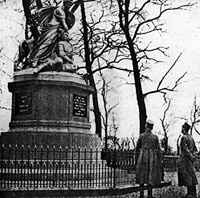 might be omitted. For those who wish to create the possibility for a Spanish last stand in the monastery, it might be of use. Most important features are the hill and the treacherous terrain
between the hill and the road. The part of the battlefield which would do for a wargames table, approximately measured some 500 metres from North to South and 800 metres From West to East. This roughly includes the West part of the high ground and the approach road of Aremberg. It will depend on the ground scale your rules use, how large the table will have to be. WRG renaissance rules use a ground-scale of 1"=10 paces for 25mm scale, requiring a
table of about 1.75 x 3.00 metres. If you want to include the monastery that part of the battlefield measures 600 x 1,100 metres.
might be omitted. For those who wish to create the possibility for a Spanish last stand in the monastery, it might be of use. Most important features are the hill and the treacherous terrain
between the hill and the road. The part of the battlefield which would do for a wargames table, approximately measured some 500 metres from North to South and 800 metres From West to East. This roughly includes the West part of the high ground and the approach road of Aremberg. It will depend on the ground scale your rules use, how large the table will have to be. WRG renaissance rules use a ground-scale of 1"=10 paces for 25mm scale, requiring a
table of about 1.75 x 3.00 metres. If you want to include the monastery that part of the battlefield measures 600 x 1,100 metres.
Our problem is that we haven't yet found a rule set which covers the 80 Years War during the 2nd half of the 16th Century, which ranges from company to 'brigade' level. We're trying to date back Pete Berry's 'File Leader' rules to this period. If anyone has any suggestions please drop a line.
THE WHAT IF? SCENARIO
As I stated earlier, Count Megen was approaching from the South with a second small army to assist Aremberg. He came too late however, meeting the stragglers of Aremberg's army at about 1 mile distant from the battlefield. The force he lead comprised the following troops:- 4 companies of his own (Low German) regiment, averaging some 375 men each, totalling 1,500 men;
- 3 light cavalry companies under command of Martinengo:
- 1 Spanish company of Cesar d'Avalos,
- 1 Italian company of Curtius Martinengo,
- 1 Albanian company of Ruy Lopez d'Avalos.
- The companies averaged 100 men each and were armed with a light lance.
His own Bande d' Ordonnance, which he probably left behind to guard the frontier, since the terrain in Groningen was not suited for (heavy) cavalry actions. So Megen's reinforcements numbered about 1,800 men, on a 1:20 figure scale totalling 90 figures.
On the other hand, Louis of Nassau was also expecting reinforcements. However from contemporary accounts we read that that most arrived a week after the battle with only the cavalry under Schauenburg arriving within 1-2 days. Since, due to the terrian, cavalry would be of doubtful usefulness, the possibility of an earlier arrival could be ignored. So when choosing a 'what if' scenario, I think it should be played with the possibility of only Aremberg having the chance of being reinforced. The time of Megen's arrival should be determined by chance, the light cavalry arriving first, since these were sent ahead. I would like to hear from anyone who has attempted to recreate Heiligerlee. Next in the series I'm preparing an article on the battle of Mook in 1574. If anyone has a request for a particular action during this period and the editor permitting, I'll try to realize it.
The absence of real uniforms or even uniformity in clothing and the vague information on flags offers the wargamer/painter a certain amount of freedom. I've managed to acquire a certain amount of information on dress, equipment and flags of both armies. Although it's perhaps beyond the scope of this magazine, it might be of interest to devote an article on it, also because I intend to write some more articles on battles during this early period of the 80 Years War. I also refer to my series on the 80 Years war in Renaissance N&Q.
FURTHER READING
Although this article has been complied from several contemporary accounts and some more modern sources, I'll only mention the most important ones, which are unfortunately mostly not in English.
'De overwinning bij Heligerlee', J.G.G.H. Hamm
Leiden 1947
Commentaries sur les evenements de la guerre des Pays-Bas 1567-1577',
Bernardino de Mendoca
A translation in French by Colonel Guilaume;
Brussels 1860
'Wilhelm von Oranien und der Niederlandische mAufstand',
F.Rachfahl
Vol.III (The Hague 1924)
'The rise of the Dutch Republic',
J.Motley
(London 1868)
Only recently a museum has opened at Heilgerlee. Visitors can now experience how the common people in the 16th century learnt what was happening around them in The Netherlands and throughout Europe. Visitors are introduced to the orgins of the chapel of Heilgerlee monastery, hearing the latest news of the battle. The museum also includes an overview of the further proceedings of the 80 Years War.
Back to Battlefields Vol. 1 Issue 6 Table of Contents
Back to Battlefields List of Issues
Back to Master Magazine List
© Copyright 1997 by Partizan Press.
This article appears in MagWeb (Magazine Web) on the Internet World Wide Web.
Other military history articles and gaming articles are available at http://www.magweb.com